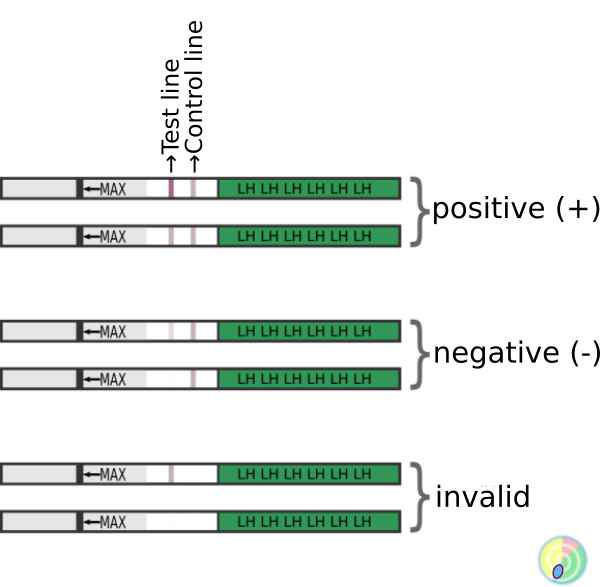Can one get pregnant with LH tests? Can ovulation tests really indicate ovulation? In this article, I share with you my experiences.
How do LH tests work?
The basic idea of an LH test is very simple because shortly before ovulation the concentration of the Luteinizing Hormone (LH) increases significantly and drops again significantly after ovulation. Thus it makes sense to determine the LH peak/increase using urine tests. The following example shows how an LH test works:
For example, you can make such a urine test in the morning. If the LH tests show two distinct strokes, the test is positive and you are just before the ovulation period. If the test does not show a second stroke, it is negative and therefore ovulation is not yet in sight or is already over. In case of an invalid Tests result, then something went wrong when measuring the LH Level – The test may also be faulty.
LH Tests 10 miu/ml or 20 miu/ml?
You may have noticed that there are different levels of concentration for LH tests. One speaks colloquially of 10s or 20s LH test strips. But which ones are better to limit ovulation? Well, this question is not so easy to answer, because it is different from one woman to another as shown in the following graph:
Mrs A has a relatively high LH level, which is well above 10 miu/ml from the base level. For this reason, a highly sensitive LH test with a concentration of 10 miu/ml would always show positive and would, therefore, be completely unsuitable. In this case, Mrs A would have to resort to LH tests with a concentration of 20 miu/ml, because this is the only way to get a clear result.
Mrs B has a relatively low LH level from the base level, which is usually well below 10 miu/ml. For Mrs B, the 20s tests are not recommended, because they would always show negative – since this woman also never reaches the high concentration of 20 miu/ml at the LH Peak just before ovulation. It is therefore much better with highly sensitive LH tests, with a concentration of 10 miu/ml. By the way, I also belong to this category of women (B).
The problem is that not all women can be categorized as 10s or 20s women, and so some women repeatedly face challenges in the application of Ovulation tests. If the LH base level, for example, is at 18 Miu/ml, then in the worst case, an LH test may even show positive results multiple times in the cycle without you actually ovulating. If the LH base level is well below 10, even the highly sensitive LH tests may not be sufficient and the tests will always show negative. I have impressively demonstrated this in my article. Ovulation tests Experience. So far, the industry has not yet invented a product that evaluates the relative LH levels. It is rather crucial whether the LH concentration is greatly increased in comparison with the base level just before ovulation – the extent of the base level can be very different from one woman to another.
Can an LH test indicate ovulation?
Already from the considerations on the base level and the functioning of the LH tests, it should be quickly realized that with LH tests the ovulation is not reliably estimated. To make matters worse, the LH can fluctuate enormously in the course of the cycle and even within a day even within a few hours. As a result, the respective urine measurements over the day is not necessarily reliable. The fluctuations usually result from the wave-shaped ovum, which has just ups and downs and therefore has to be understood as a highly complex hormonal interaction. As the last point, I would like to point out that LH, together with some 100 other sex hormones, is suspected of triggering ovulation. The exact hormonal relation with regard to the release of ovulation is still a relevant research topic. Scientifically, one has to ask the question of what the other 99 hormones do at an LH surge? In the case of advanced hormone computers, such as the Clearblue Fertility Monitor, several hormones, such as the E3, are measured in urine. The results, however, are significantly more expensive tests and acquisition costs for the consumer. To date, however, no test is really 100% reliable. Thus, a positive LH test for me is indeed an interesting additional information, whether one is close to ovulation – but not more. To rely on it alone, LH tests would be too uncertain and inaccurate.
My last best tip
If you really want to know if you have an ovulation and when exactly your ovulation is, then I recommend you to employ the Symptothermal Method. With the Symptothermal Method, the temperature in combination with the cervical mucus or the cervix is used in the course of the cycle to limit the highly fertile days. Studies have shown that ovulation can be narrowed down to just a few days. It is also possible to determine without any doubt whether you have an ovulation or not. In many cases, you can even perform cycle diagnostics on the basis of the temperature curve and the cervical mucus course – and thus limit the reasons why you have not yet become pregnant. If you would like to learn more about the Symptothermal Method, I recommend you my Get Pregnant Starter Set. There I have put together everything you need for the optimal start into the Symptothermal Method.






